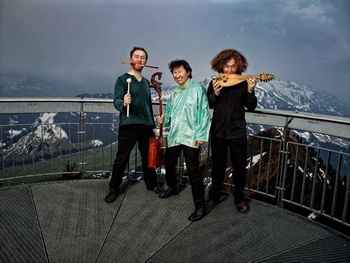(© Simon Frey)
Violons Barbares, made up of two violinists – a Mongolian and a Bulgarian – and a French percussionist, are not your normal world music trio. “We walk around carrying an ancient violin and with an iPod plugged into our ears.”
Violons Barbares brings together two violinists, the Mongolian Dandarvaanchig Enkhjargal, who plays the morin khoor, a two-string violin with a carved horse’s head, and the Bulgarian Dimitar Gougov, who plays the gadulka, which has three melodic and eleven sympathetic strings.
Tell me: how can a violin be barbarian?
Dimitar Gougov: Because, originally, the Bulgarians were regarded as barbarians by the Greeks. And the Mongols were even more barbarian! [laughter] Before it became the refined instrument of classical music that we know today, the violin was “barbarian”. The classical violin has only existed for four centuries, since it was adopted by the opera in Italy.
It is fascinating to see how the same kind of instrument with bowed or stroked strings has developed independently in various corners of the world.
Gougov: There are actually lots of cultures that have instruments with one, two, or three strings vibrated by a bow. The instrument is believed to have come from Asia and to have spread from there in every direction. The first representations in Europe date from the tenth century.
How do a Bulgarian, a Mongolian, and a Frenchman meet up to form a group?
Gougov: I met Dandarvaanchig in Germany. We were invited for a project focusing on the Silk Road, six years ago. There was a Mongolian, a Chinese, an Indian, a Turk, a Bulgarian, and a French musician. I got to know the morin khoor, a very basic instrument with two strings that makes quite a deep sound. As the gadulka is more high-pitched, the two instruments complement each other well and their tuning is almost identical. Dandarvaanchig’s diphonic (throat) singing, moreover, is quite astonishing. But there is more to the group than that: the percussionist also participates in creating the music. We ask him to play certain rhythms
and he proposes melodies by singing.
How would you describe your music? Folk and at the same time contemporary…
Gougov: No, it’s not folk at all. When someone talks about folklore, you picture traditional costumes out of museums and round dances. What we do is rock ‘n’ roll! We don’t have any traditional costumes, except for the Mongolian, who likes to put on his traditional fluorescent green outfit to dazzle your eyes! [laughter] Maybe the historic baggage of our instruments means that we necessarily carry the tradition within us. It is our starting point, from which we explore other horizons.
As on “Makedonsko” and “Barbar Rock”, tracks that truly rock. You must be the world’s oddest rock band!
Gougov: Our music can be both sophisticated and raw at the same time. We want to have fun with traditional music while playing with lots of energy and a modern spirit. We walk around carrying an ancient violin and with an iPod plugged into our ears.
Violons Barbares
15/3 • 20.30, €12/13/14
Espace Senghor Waversesteenweg 366 chaussée de Wavre, Etterbeek,
02-230.31.40, www.senghor.be

Fijn dat je wil reageren. Wie reageert, gaat akkoord met onze huisregels. Hoe reageren via Disqus? Een woordje uitleg.